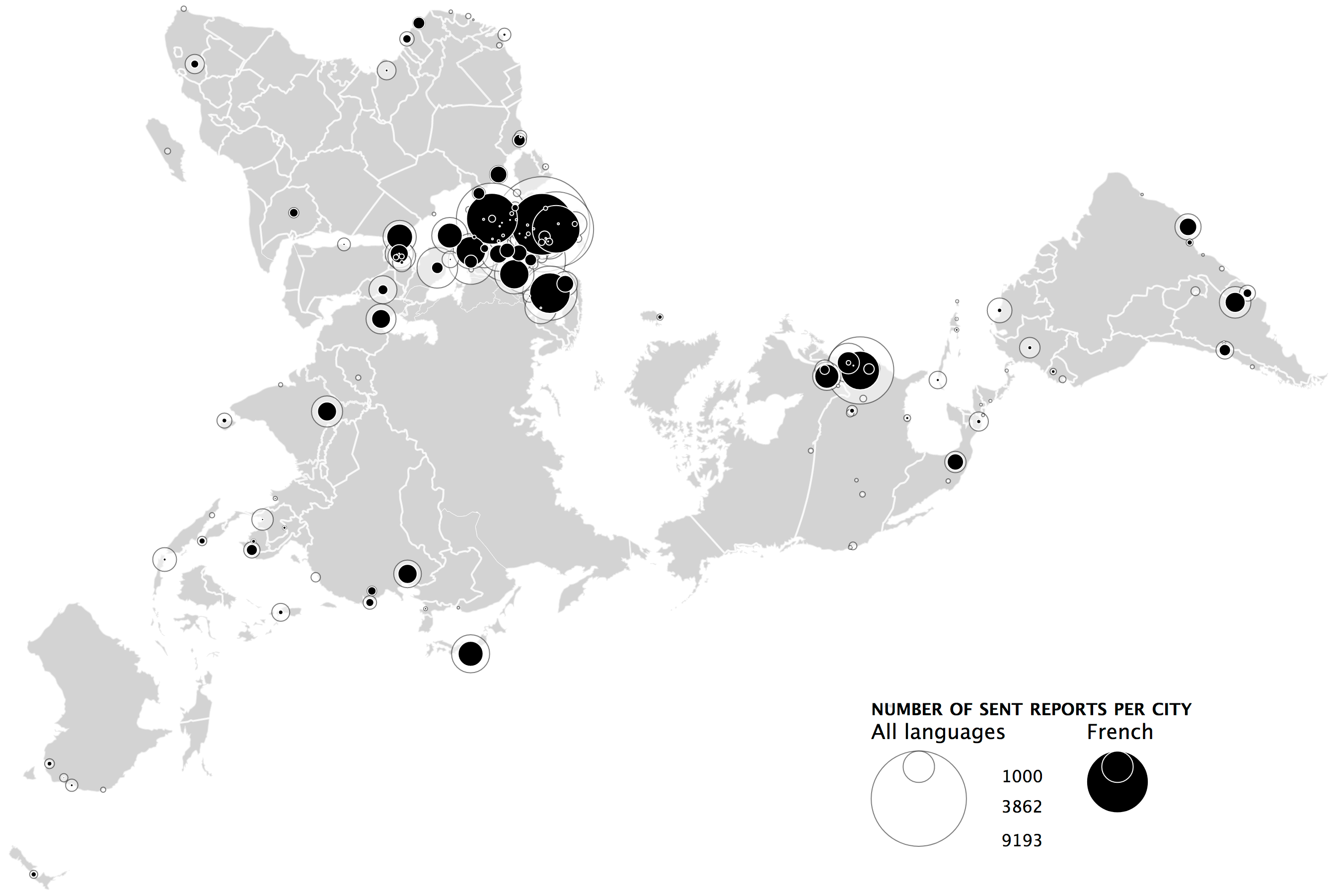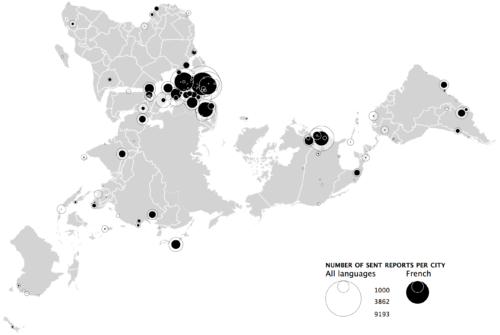The legend for proportional circles sizes is drawn automatically.
Reprojectiong on the fly from WGS84 to the newly available AirOcean (Dymaxion projection) in D3v5.
Example data: number of political reports sent by Swiss embasies to Bern in all languages and in French specifically betwee 1920 annd 1960.
Running D3 version of this map is available here.
<!DOCTYPE html>
<meta charset="utf-8">
<style>
.states1920 {
stroke: white;
stroke-width: 0.5;
fill: lightgrey;
}
.states1945 {
stroke: white;
stroke-width: 2;
stroke-opacity:0.5;
fill: none;
}
.citiesall {
fill:white;
stroke:black;
fill-opacity: 0.5;
stroke-opacity: 0.5;
}
.citiesselected {
fill:black;
stroke:white;
}
.legend{
font-family: 'Lucida Sans', 'Lucida Sans Regular', 'Lucida Grande', 'Lucida Sans Unicode', Geneva, Verdana, sans-serif;
font-size: 1.3em;
}
.legendtitle{
font-variant: small-caps;
font-weight: bold;
}
.legendscale{
font-size: 0.8em;
}
</style>
<svg width="1500" height="900"></svg>
<script src="d3/d3.v5.min.js"></script>
<script src="d3/d3-geo.v1.min.js"></script>
<script src="d3/d3-geo-projection.v2.min.js"></script>
<script src="d3/d3-geo-polygon.min.js"></script>
<script>
var svg = d3.select("svg"),
width = +svg.attr("width"),
height = +svg.attr("height");
var region = "world"; // can be world or europe.
var legendtranslate = "translate(1000,800)"; // positioning the legend
if (region == "europe") {
var projection = d3.geoPeirceQuincuncial()
.scale(1300)
.translate([0.35*width, -0.35*height])
.precision(0.1);
legendtranslate = "translate(100,350)";
} else {
var projection = d3.geoAirocean()
.scale(90)
.translate([0.5*width,0.5*height])
.precision(0.1);
}
var path = d3.geoPath()
.projection(projection);
var scaler = 2;
Promise.all([
d3.json('world_1920.geojson'),
d3.json('world_1945.geojson'),
d3.json('citiesallreports.geojson'),
d3.json('citiesselected.geojson')
]).then(([states1920,states1945,citiesall,citiesselected]) => {
svg.append("g")
.attr("class", "states1920")
.selectAll("path")
.data(states1920.features)
.enter().append("path")
.attr("d", path)
;
svg.append("g")
.attr("class", "states1945")
.selectAll("path")
.data(states1945.features)
.enter().append("path")
.attr("d", path)
;
svg.append("g")
.attr("class", "citiesall")
.selectAll("circle")
.data(citiesall.features.sort(function(a, b) { return b.properties.count - a.properties.count; }))
.enter().append("circle")
.attr("cx", function (d) { return projection(d.geometry.coordinates)[0]; })
.attr("cy", function (d) { return projection(d.geometry.coordinates)[1]; })
.attr("r", function (d) { return Math.sqrt(d.properties.count) /scaler; })
;
svg.append("g")
.attr("class", "citiesselected")
.selectAll("circle")
.data(citiesselected.features.sort(function(a, b) { return b.properties.count - a.properties.count; }))
.enter().append("circle")
.attr("cx", function (d) { return projection(d.geometry.coordinates)[0]; })
.attr("cy", function (d) { return projection(d.geometry.coordinates)[1]; })
.attr("r", function (d) { return Math.sqrt(d.properties.count) / scaler; })
;
// add a legend -----
// add maximum circle sizes
maxcitall = citiesall.features.sort(function(a, b) { return b.properties.count - a.properties.count; })[0].properties.count;
maxcitsel = citiesselected.features.sort(function(a, b) { return b.properties.count - a.properties.count; })[0].properties.count;
rmaxcitall = Math.sqrt(maxcitall)/scaler; // prepare circle radidus
rmaxcitsel = Math.sqrt(maxcitsel)/scaler;
var legend = svg.append("g").attr("class","legend").attr("transform",legendtranslate);
legend.append("circle").attr("class","citiesall").attr("r",rmaxcitall); // the center of this one one serves as a reference point for the other elements. This center is at position 0,0 with respect to the g element, which we have translated
legend.append("circle").attr("class","citiesall").attr("r",Math.sqrt(1000)/scaler)
.attr("cy",-(rmaxcitall-Math.sqrt(1000)/scaler))
;
legend.append("text").text("number of sent reports per city")
.attr("class","legendtitle")
.attr("x",-rmaxcitall)
.attr("y",-rmaxcitall-36)
;
legend.append("text").text("All languages")
.attr("x",-rmaxcitall)
.attr("y",-rmaxcitall-12)
;
legend.append("text").text("French")
.attr("x",-(rmaxcitsel) + 200)
.attr("y",-rmaxcitall-12)
;
legend.append("circle").attr("class","citiesselected").attr("r",rmaxcitsel)
.attr("cx",200)
.attr("cy",-(rmaxcitall-rmaxcitsel))
;
legend.append("circle").attr("class","citiesselected").attr("r",Math.sqrt(1000)/scaler)
.attr("cx",200)
.attr("cy",-(rmaxcitall-Math.sqrt(1000)/scaler))
;
legend.append("text").text("1000").attr("class","legendscale")
.attr("x",rmaxcitall+35)
.attr("y",-rmaxcitall+ Math.sqrt(1000)/scaler*2) // *2 because interested in diameter not radius, here
;
legend.append("text").text(maxcitsel).attr("class","legendscale")
.attr("x",rmaxcitall+35)
.attr("y",-rmaxcitall+rmaxcitsel*2)
;
legend.append("text").text(maxcitall).attr("class","legendscale")
.attr("x",rmaxcitall+35)
.attr("y",rmaxcitall)
;
});
</script>

